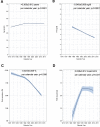Change in newly diagnosed Graves' disease phenotype between the twentieth and the twenty-first centuries: meta-analysis and meta-regression
- PMID: 33346898
- PMCID: PMC8285314
- DOI: 10.1007/s40618-020-01479-z
Change in newly diagnosed Graves' disease phenotype between the twentieth and the twenty-first centuries: meta-analysis and meta-regression
Abstract
Purpose: According to a few recent studies, the clinical phenotype of Graves' disease (GD) at onset is becoming milder in recent years, in terms of prevalence and severity of hyperthyroidism, goiter and overt eye disease. The aim of this study was to assess the change in GD phenotype across the late twentieth and the early twenty-first centuries.
Materials and methods: We carried out a systematic search of studies published between 1/1/1980 and 12/31/2017 describing naïve GD patients at diagnosis. We collected epidemiological, clinical, biochemical and serological data reported in the selected studies, and (1) conducted a single-arm meta-analysis to compare clinical and biochemical characteristics of naïve GD patients before and after year 2000 and (2) performed a meta-regression to identify the trend of the observed clinical presentations.
Results: Eighty selected articles were related to the period before the year 2000, 30 to the years 2000-2017. According to demographics, the two defined populations were homogeneous at meta-analysis: overall estimated female prevalence was 81% [95% CI 79-82], mean estimated age of the entire population was 39.8 years [95% CI 38.4-41.1], with no significant differences between pre- and post-2000 groups (p > 0.05). The overall estimated prevalence of smokers was 40% [95% CI 33-46], with no significant difference between the two groups (p > 0.05). Mean estimated free thyroxine (FT4) and free triiodothyronine (FT3) levels at diagnosis were higher in the pre-2000 group: 4.7 ng/dl [95% CI 4.5-4.9] for FT4 and 14.2 pg/ml [95% CI 13.3-15.1] for FT3, as compared to the post-2000 group: 3.9 ng/dl [95% CI 3.6-4.2] for FT4 and 12.1 pg/ml [95% CI 11.0-13.3] for FT3 (all p < 0.01). Goiter estimated prevalence was higher in the pre-2000 group, 87% [95% CI 84-90], than in the post-2000 group, 56% [95% CI 45-67]. Estimated prevalence for Graves' Orbitopathy (GO) was 34% [95% CI 27-41] in the pre-2000 group and 25% [95% CI 19-30] in the post-2000 group (p = 0.03). Accordingly, meta-regression adjusted for covariates showed an average annual reduction of FT4 (- 0.040 ± 0.008 ng/dl, p < 0.0001), FT3 (- 0.316 ± 0.019 pg/ml, p < 0.0001), goiter prevalence (- 0.023 ± 0.008%, p = 0.006), and goiter size (- 0.560 ± 0.031 ml, p < 0.0001).
Conclusions: Our meta-analysis and meta-regression confirmed that GD phenotype at diagnosis is nowadays milder than in the past; we hypothesize that conceivable factors involved in this change are iodoprophylaxis, worldwide decrease in smoking habits, larger use of contraceptive pill and micronutrient supplementation, as well as earlier diagnosis and management.
Keywords: Autoimmunity; Goiter; Graves’ disease; Graves’ orbitopathy; Hyperthyroidism.
© 2020. The Author(s).
Conflict of interest statement
All the authors declare that they have no conflict of interest.
Figures


References
Publication types
MeSH terms
LinkOut - more resources
Full Text Sources
Medical
Miscellaneous

